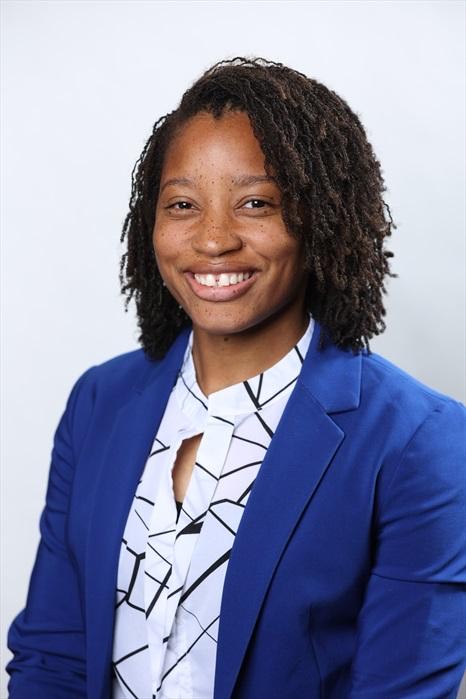10.20.2022
By uscbknpt
Providing Physical Therapy Behind Bars

Photo by Will Hartman/Desert Rose Photography
Recent graduate Wendy Johnson’s career path has taken an unusual trajectory — treating patients at the California Institute for Women.
BY ANDREW FAUGHT
FAMILY AND FRIENDS WEREN’T SURE WHAT TO MAKE of Wendy Johnson DPT 21’s decision to become a physical therapist at the California Institute for Women (CIW) in Corona, Calif., one of two female penitentiaries in the state.
“A lot of them were very worried about my safety,” Johnson says. “But in all honesty, it’s one of the safest places around. There are correctional officers all around the facility, and I keep an alarm on me all the time. I’m also required to have a whistle, just in case.”
Inmates arrive at Johnson’s office with all of the same niggling chronic pain as the outside world, including lower back, neck and knee injuries.
The unique setting does require some extra precautions. When Johnson cuts resistance bands for her patients, she retreats to a corner to use her scissors. She then locks them in a compartment, never turning her back to a patient.
Johnson has worked at the 940-inmate facility since March, the lone physical therapist on staff. She keeps a busy docket, seeing her first patient at 7 a.m. Some days can stretch to 13 half-hour appointments. Patients typically see Johnson weekly for four weeks — or twice a week after a surgery.
She relies on the core tools of physical therapy: heat and ice, as well as her hands to ease muscle pain and manipulate joints. Inmates also use a cable machine to work multiple muscle groups with varying resistance.
Everybody Deserves Healthcare
Johnson doesn’t differentiate between her patients and the world outside the prison walls.
“I feel everybody should have equal access to healthcare, despite what they’ve done,” she says. “They still need help. A lot of them are sorry and they want redemption. They want to get out and have a life. I try to treat them just as I would treat somebody in an outpatient setting.”
After earning a biology undergraduate degree (and chemistry minor) at Texas Southern University, Johnson decided to pursue physical therapy for the field’s job security, but also for reasons that hit closer to home.
Growing up in Sacramento, she relied on physical therapists to treat injuries — a broken finger and knee pain — she suffered while playing high school basketball and soccer; she also competed on the golf team.
Before joining CIW, she worked for several months providing home health care for homebound clients, typically senior citizens who needed fall recovery and post-surgical physical therapy. Johnson prefers a prison setting because, unlike private practice, she doesn’t have to meet productivity quotas or navigate byzantine insurance regulations.
Depending on their offenses, prisoners are afforded varying mobility in Johnson’s office. Unlike general population inmates, those with a maximum-security classification wear shackles and are accompanied to their sessions by a pair of guards, who remain in the treatment room at all times.
Representation Matters
Johnson refers to all patients by their last names; they know her as Dr. Johnson. When she started the job, Johnson didn’t ask inmates about their criminal pasts, “because I didn’t want it to affect my treatment. But, eventually, I started to ask, and it didn’t affect how I looked at them. I was treating them the same as anyone else.
“A lot of them tell me their dreams,” she adds. “They’ll open up to be about what they want to do when they get out. I listen, and I don’t ever shut them down. That’s something they don’t get a lot of — someone listening to them.”
But there’s something more that resonates with the inmates.
Johnson is among the tiny 3 percent share of California physical therapists who are Black. In California, 25.9 percent of all female inmates are African American. Johnson’s presence hardly goes unnoticed. (Nationally, the share of Black physical therapists is just 5 percent.) “They look at me with more respect,” Johnson says. “They’ll walk in and say, ‘Finally, somebody of color!’”
A lot of them tell me their dreams. They’ll open up to be about what they want to do when they get out. I listen, and I don’t ever shut them down. That’s something they don’t get a lot of — someone listening to them.
Johnson says she was one of two Black students in her physical therapy class. While the lack of diversity was at first “depressing,” Johnson talked out her concerns with professors, who encouraged her along her academic journey.
Perhaps surprisingly, Johnson says her prison patients — despite their ample free time — can be just as stubborn as the rest of the world when it comes to being a committed partner in their physical rehabilitation and recovery.
Many refuse to continue treatments after an initial appointment; the state does not require inmates to seek therapeutic help.
Off work, Johnson channels some of her former athleticism to decompress. She’s taken up bowling, a new hobby that’s become “my thing.” “I even got my own bowling ball and shoes,” she notes. (To date, her high score is 130.) Bowling, unlike contact sports, is complementary to Johnson’s profession.
Sizing up the pins, she practices what she preaches: “At the end of the day,” she says, “it’s all about body mechanics and posture.

